|
|
Post by deuce on Oct 14, 2018 20:39:08 GMT -5
Good look at how Japanese swords were viewed by the West during the early Modern era:
|
|
|
|
Post by kemp on Oct 15, 2018 9:47:58 GMT -5
Interesting video Deuce, well balanced. Yes, the Japanese sword had it's place, but those post medieval Dutch and Portugese sailors who first encountered the Japanese Katana did not ditch their own blades in preference for the sword types they encountered in Japan, they actually preferred their own European swords. Having said that, many Europeans appreciated the inherent beauty and craftmanship of the Japanses sword, and the fact that these far eastern blades had their own use in some martial applications, including civilian defence. There are people around these days who absolutely adore Japanese Katanas and try to belittle European swords, and there are western martial artists who believe that the European longsword is the best thing out when it comes to swords and that the Katana is crap made from impure steel. I am one of those people that hold that both western and eastern sword types have their uses, and that the weapons were created to suit certain period styles of fighting against various lightly and heavily armoured opponents. For instance certain European thrusting swords would have held up much better against European plate armour. A spring tempered European sword would also be less likely to suffer the same chip damage as a Katana impacting against good plate or mail armour. The Katana was a good slashing weapon against lamellar armoured samurai, with a full hard edge supported by a tough softer back capable of inflicting lethal cuts.  Albion Mercenary  Yoshindo Yoshihara swords |
|
|
|
Post by kemp on Oct 17, 2018 7:15:59 GMT -5
The Rhomphaia The rhomphaia was a close-combat bladed weapon used by the Thracians as early as 400 BC. Rhomphaias were polearms with a straight or slightly curved single-edged blade attached to a pole, which in most cases was considerably shorter than the blade. Although the rhomphaia was similar to the falx, most archaeological evidence suggests that rhomphaias were forged with straight or slightly curved blades, presumably to enable their use as both a thrusting and slashing weapon.  Looks almost like a kind of scythe sword hybrid. 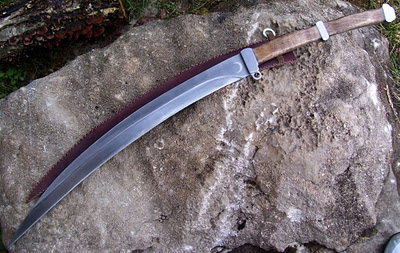 A Dacian falx repro for comparison.  The falx seemed more oriented towards the cut, whereas the rhomphaia could also be utilised as a thrusting weapon. In both cases the cutting edge is on the inside of the curve. It is probably more correct to designate the rhomphaia and falx as types of polearms rather than swords. |
|
|
|
Post by Char-Vell on Oct 18, 2018 15:54:03 GMT -5
The Rhomphaia The rhomphaia was a close-combat bladed weapon used by the Thracians as early as 400 BC. Rhomphaias were polearms with a straight or slightly curved single-edged blade attached to a pole, which in most cases was considerably shorter than the blade. Although the rhomphaia was similar to the falx, most archaeological evidence suggests that rhomphaias were forged with straight or slightly curved blades, presumably to enable their use as both a thrusting and slashing weapon.  Looks almost like a kind of scythe sword hybrid.  A Dacian falx repro for comparison.  The falx seemed more oriented towards the cut, whereas the rhomphaia could also be utilised as a thrusting weapon. In both cases the cutting edge is on the inside of the curve. It is probably more correct to designate the rhomphaia and falx as types of polearms rather than swords. The falx/ rhomphaia is another cool weapon that's underrepresented in fiction. |
|
|
|
Post by kemp on Oct 19, 2018 9:10:00 GMT -5
The Rhomphaia The rhomphaia was a close-combat bladed weapon used by the Thracians as early as 400 BC. Rhomphaias were polearms with a straight or slightly curved single-edged blade attached to a pole, which in most cases was considerably shorter than the blade. Although the rhomphaia was similar to the falx, most archaeological evidence suggests that rhomphaias were forged with straight or slightly curved blades, presumably to enable their use as both a thrusting and slashing weapon.  Looks almost like a kind of scythe sword hybrid.  A Dacian falx repro for comparison.  The falx seemed more oriented towards the cut, whereas the rhomphaia could also be utilised as a thrusting weapon. In both cases the cutting edge is on the inside of the curve. It is probably more correct to designate the rhomphaia and falx as types of polearms rather than swords. The falx/ rhomphaia is another cool weapon that's underrepresented in fiction. I agree. I know that you have included some of these less seen weapons in your stories. History is a great source, and Europe, Asia and Africa have a long history of cool looking ( and very functional ) blade oriented weapons. |
|
|
|
Post by kemp on Oct 29, 2018 8:54:08 GMT -5
Some time back I posted something on swords being semi retired these days as opposed to outright obsolete weapons. One of examples I used was the Ginunting sword still used by the Philippines marines. They also use the Bolo which I should have included.  |
|
|
|
Post by kemp on Oct 29, 2018 8:57:30 GMT -5
Gurkha Soldiers in Indian , Nepalese as well as in the UK army still carry their trademark Khukuris . Kinda big knife/short sword status.  Friendly looking bunch. |
|
|
|
Post by kemp on Nov 3, 2018 9:28:07 GMT -5
All the blade types that I have covered up to this point, knives, swords, and everything else in between have one thing in common; They have fixed handles, and I prefer the sturdy fixed handle design for the big knives. For small knives, utility types, I like folding knives. I own a Voyager Cold Steel one hand opener that I use for all sorts of everyday tasks, mostly cutting and marking fibrous materials. Looks very much like this one.  |
|
|
|
Post by kemp on Nov 3, 2018 9:34:11 GMT -5
Of course history does record some very big and impressive folding knives, perhaps the Navaja is the best example, a traditional Spanish ( also adopted in parts of France and Corsica ) folding blade used for both fighting and utlity purposes. Spanish folding knives have an ancient history, but the distinct Navaja looking knives go back to the 1600’s. Antique Spanish Navaja ![]() 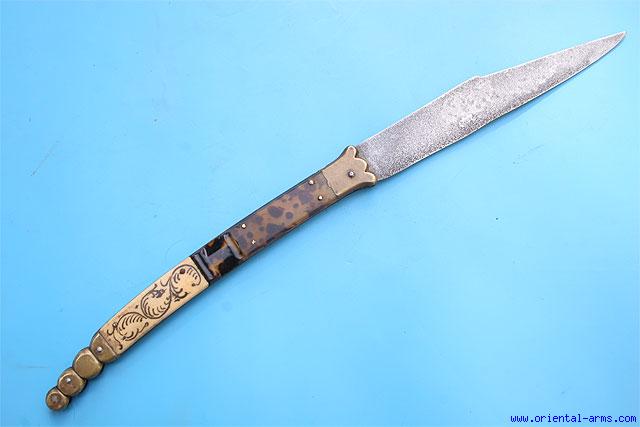 Note the Yataghan style blade on this example, also the stag horn handle and the pull ring for disengaging the blade locking mechanism. 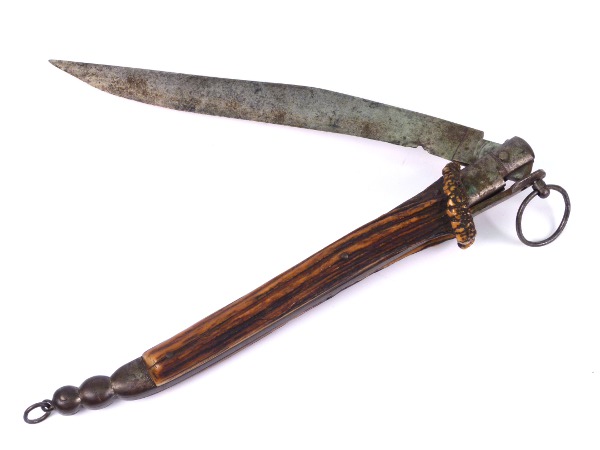 |
|
|
|
Post by kemp on Nov 3, 2018 9:47:14 GMT -5
The navaja was first adopted as a fighting knife by the peoples of Andalusia in southern Spain, including the Spanish gypsies of the day, the Gitanos. Knife fighting schools of the 18th and 19th century taught fighting with the navaja. Used as a fighting knife, the navaja typically sported a 4 inch blade, but knives with 6 and 8 inch blades were also common. 'The ominous click-clack of a navaja de muelles was a sound dreaded by lone travellers attempting to negotiate lonely rural highways or the Byzantine back streets of medieval Spanish cities after dark. The knife's popularity among lawless elements in Spain is attested to in James Loriega's book Sevillian Steel. Loriega writes, Navajas crossed the hands and drew the blood of soldiers and sailors, rogues and ruffians, and diplomats and aristocrats both in and out of Spain's borders. The use of the navaja fostered a mystique, not only from Seville's back streets, but also from the seedy waterfronts of Barcelona, and the cosmopolitan promenades of Madrid. Regardless of their original intent, the navaja represented the ultimate means for resolving disagreements, misunderstandings, and problems that arose in dockside bars, darkened alleys, and an untold number of places not found in any guidebook; places where there is little reliance on legal recourses; places where you either catch a glimpse of steel and live - or miss it, and never know why you died.' en.wikipedia.org/wiki/Navaja |
|
|
|
Post by kemp on Jan 15, 2019 9:21:59 GMT -5
Some of the Bayonet designs are short swords in their own right. WWII Serbian Mauser Bayonet.  |
|
|
|
Post by kemp on Jan 15, 2019 9:24:16 GMT -5
American WW1 P1917 Remington Bayonet. 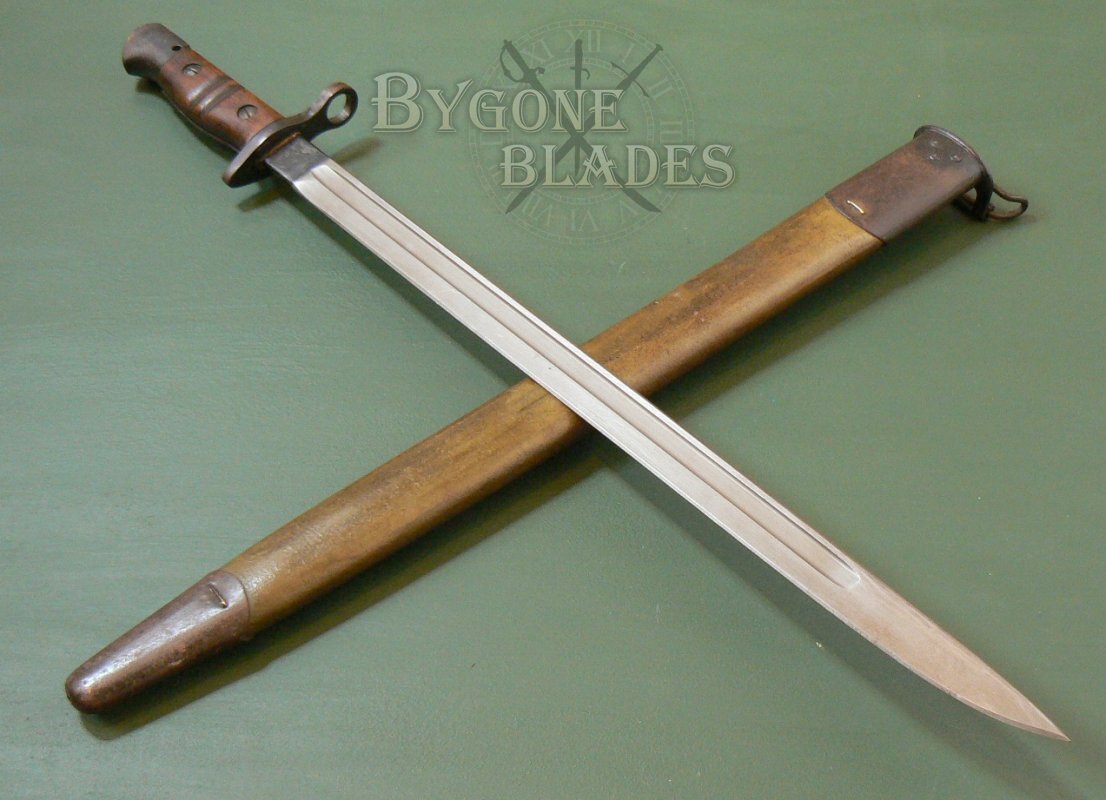 |
|
|
|
Post by kemp on Jan 15, 2019 9:25:43 GMT -5
Would not be right if I did not include an Aussie model. Australian World War II Era Bayonet  |
|
|
|
Post by kemp on Jan 20, 2019 0:55:20 GMT -5
Most of my focus has been on historical sword types, or inspired in strong part from historical examples, but I thought I would have a little fun and look at some of the tactical and zombie slaying style blades. I remember this guy that bought a used drill press from me, eyeing the cheap ‘battle ready’ sword I had in my garage and remarking something about its effectiveness against ….zombies. I think he liked the blade, not impressed enough to buy it when I offered it up for sale to him, said his wife would not let him keep it. I suggested he tell his wife it was the latest in gardening tools, but he said that his wife wouldn't buy into that. Anyways, it made me think that if zombies existed people would want big blades that could chop and cleave the undead for when the bullets ran out, perhaps in some ways more effective against zombies than guns, although you have to get close. Some of these weapons would be expertly forged/ground tactical weapons, and some would be backyard post apocalypse swords made from readily available materials and in varying degrees of quality and effectiveness. Machetes are hands down at the top of the list due to their utilitarian and multipurpose nature, true survivalist blades, kind of hybrid sword/big knife. Keeping in line with the slightly fantasy feel I posted this survival machete .  |
|
|
|
Post by kemp on Jan 20, 2019 1:00:51 GMT -5
The Katana has infiltrated popular culture and imagination when it comes to tactical zombie slayers. Tactical Ko Katana  Cleavers, how about the Zombie Reaver Cleaver  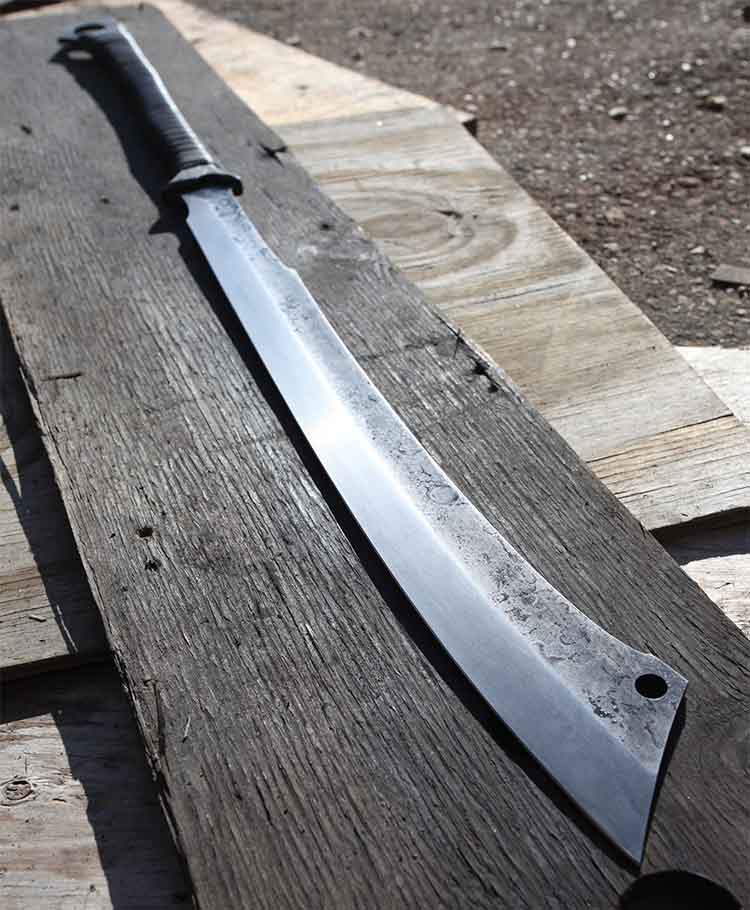 Really like the cleaver, dig that rough finish along the spine. Screams zombie slayer. |
|